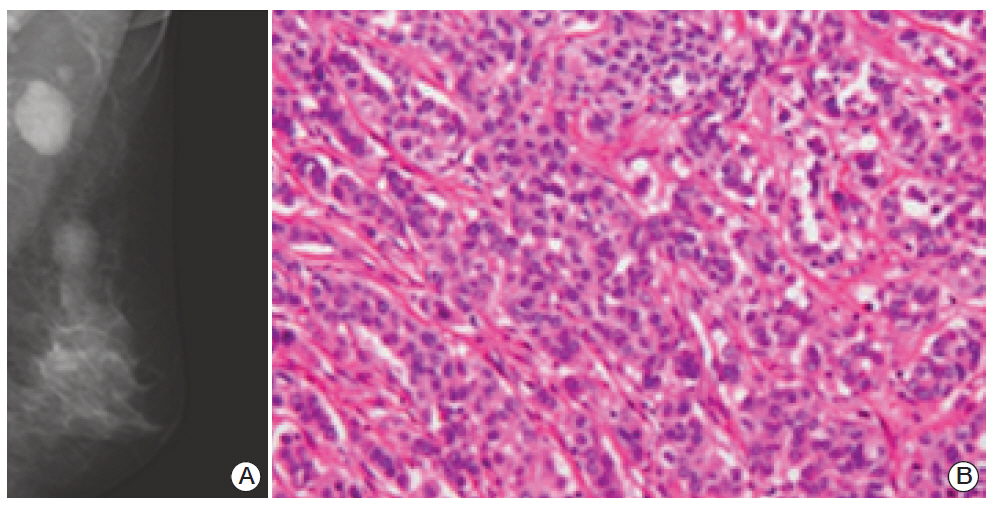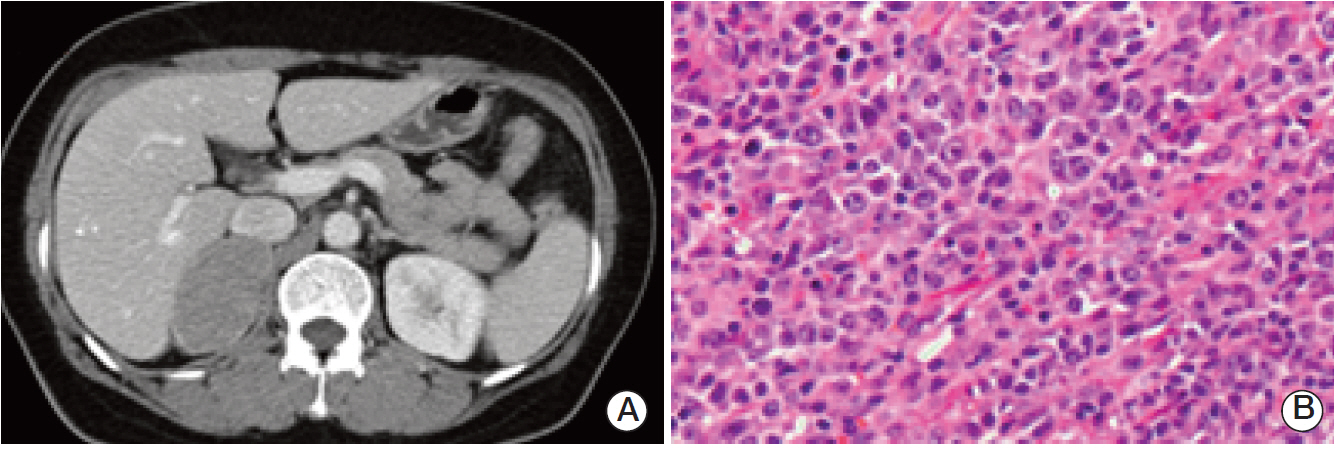Cancer Res Treat.
2015 Jul;47(3):534-538. 10.4143/crt.2013.151.
Novel Germline Mutation of BRCA1 Gene in a 56-Year-Old Woman with Breast Cancer, Ovarian Cancer, and Diffuse Large B-Cell Lymphoma
- Affiliations
-
- 1Division of Oncology/Hematology, Department of Internal Medicine, Korea University College of Medicine, Seoul, Korea. khpark@korea.ac.kr
- 2Department of Pathology, Ewha Womans University School of Medicine, Seoul, Korea.
- 3Division of Hematology-Oncology, Department of Medicine, Ewha Womans University School of Medicine, Seoul, Korea.
- KMID: 2148505
- DOI: http://doi.org/10.4143/crt.2013.151
Abstract
- We report a case of a 56-year-old woman with breast cancer, ovarian cancer, and diffuse large B-cell lymphoma with a BRCA1 gene mutation. Evidence is mounting that there is a large increase in the risk for hematologic malignancies among patients with genetic changes in the BRCA pathways. The genomic analysis demonstrated a frameshift mutation in the BRCA1 gene: 277_279delinsCC (Phe93fs). It is a novel BRCA1 mutation that has never been reported, and caused malignant lymphoma as well as breast and ovarian cancer.
Keyword
MeSH Terms
Figure
Reference
-
References
1. Ko SS; Korean Breast Cancer Society. Chronological changing patterns of clinical characteristics of Korean breast cancer patients during 10 years (1996-2006) using nationwide breast cancer registration on-line program: biannual update. J Surg Oncol. 2008; 98:318–23.
Article2. Robson ME, Boyd J, Borgen PI, Cody HS 3rd. Hereditary breast cancer. Curr Probl Surg. 2001; 38:387–480.
Article3. Miki Y, Swensen J, Shattuck-Eidens D, Futreal PA, Harshman K, Tavtigian S, et al. A strong candidate for the breast and ovarian cancer susceptibility gene BRCA1. Science. 1994; 266:66–71.4. Wooster R, Bignell G, Lancaster J, Swift S, Seal S, Mangion J, et al. Identification of the breast cancer susceptibility gene BRCA2. Nature. 1995; 378:789–92.
Article5. Easton DF, Ford D, Bishop DT. Breast and ovarian cancer incidence in BRCA1-mutation carriers. Breast Cancer Linkage Consortium. Am J Hum Genet. 1995; 56:265–71.6. Kerr P, Ashworth A. New complexities for BRCA1 and BRCA2. Curr Biol. 2001; 11:R668–76.
Article7. Friedenson B. The BRCA1/2 pathway prevents hematologic cancers in addition to breast and ovarian cancers. BMC Cancer. 2007; 7:152.
Article8. Ahn SH, Hwang UK, Kwak BS, Yoon HS, Ku BK, Kang HJ, et al. Prevalence of BRCA1 and BRCA2 mutations in Korean breast cancer patients. J Korean Med Sci. 2004; 19:269–74.
Article9. Hedau S, Jain N, Husain SA, Mandal AK, Ray G, Shahid M, et al. Novel germline mutations in breast cancer susceptibility genes BRCA1, BRCA2 and p53 gene in breast cancer patients from India. Breast Cancer Res Treat. 2004; 88:177–86.
Article10. Khoo US, Chan KY, Cheung AN, Xue WC, Shen DH, Fung KY, et al. Recurrent BRCA1 and BRCA2 germline mutations in ovarian cancer: a founder mutation of BRCA1 identified in the Chinese population. Hum Mutat. 2002; 19:307–8.
Article11. Kang HC, Kim IJ, Park JH, Kwon HJ, Won YJ, Heo SC, et al. Germline mutations of BRCA1 and BRCA2 in Korean breast and/or ovarian cancer families. Hum Mutat. 2002; 20:235.12. Han SA, Park SK, Ahn SH, Lee MH, Noh DY, Kim LS, et al. The Korean Hereditary Breast Cancer (KOHBRA) study: protocols and interim report. Clin Oncol (R Coll Radiol). 2011; 23:434–41.
Article13. Risch HA, McLaughlin JR, Cole DE, Rosen B, Bradley L, Kwan E, et al. Prevalence and penetrance of germline BRCA1 and BRCA2 mutations in a population series of 649 women with ovarian cancer. Am J Hum Genet. 2001; 68:700–10.
Article14. Shih HA, Nathanson KL, Seal S, Collins N, Stratton MR, Rebbeck TR, et al. BRCA1 and BRCA2 mutations in breast cancer families with multiple primary cancers. Clin Cancer Res. 2000; 6:4259–64.15. Chen Y, Zheng T, Lan Q, Kim C, Qin Q, Foss F, et al. Polymorphisms in DNA repair pathway genes, body mass index, and risk of non-Hodgkin lymphoma. Am J Hematol. 2013; 88:606–11.
Article
- Full Text Links
- Actions
-
Cited
- CITED
-
- Close
- Share
- Similar articles
-
- A Study for Germline Mutation of BRCA1 in Early Onset Breast Cancer Patients
- Frequency of BRCA1 and BRCA2 Germline Mutations Detected by Protein Truncation Test and Cumulative Risks of Breast and Ovarian Cancer among Mutation Carriers in Japanese Breast Cancer Families
- Germline Mutations of BRCA1 Gene in Korean Breast and/or Ovarian Cancer Families
- A Novel Germline Mutation in BRCA1 Causes Exon 20 Skipping in a Korean Family with a History of Breast Cancer
- One Korean Patient with a Family History of BRCA1-associated Ovarian Cancer





